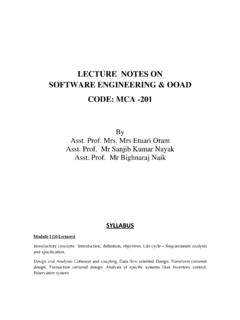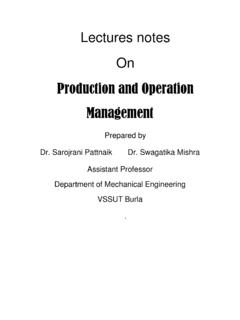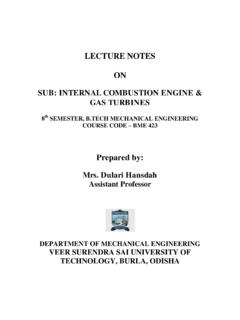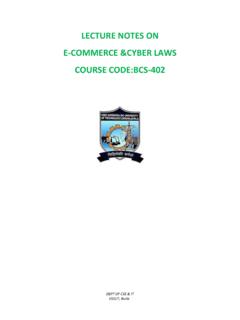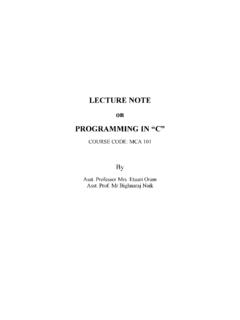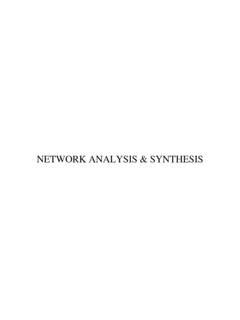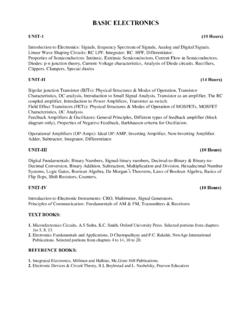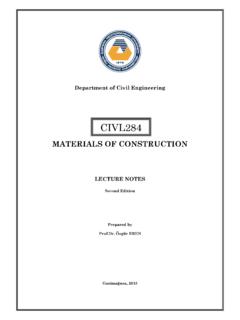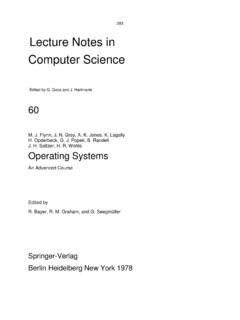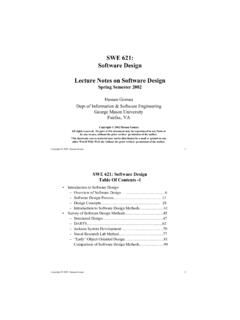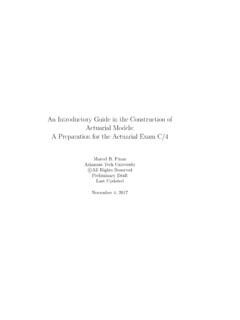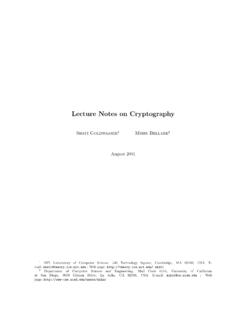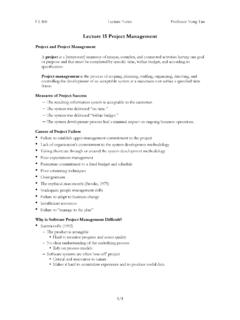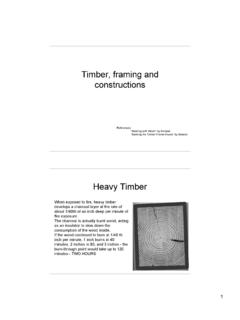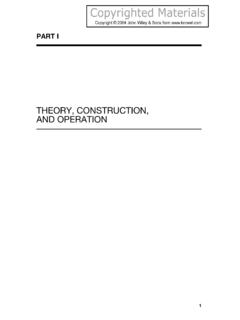Transcription of LECTURE NOTE COURSE CODE- BCE 305
1 *Under revision LECTURE NOTE COURSE code - BCE 305 TRANSPORTATION ENGINEERING-I *Under revision SYLLABUS Module-I Transportation by roads, railways, water ways & air ways their importance& limitation. Road development & planning in India. Financing, Highway alignment & engineering surveys for highway location. Geometric design-Cross section elements, Design speed, sight distance, super elevation, horizontal & vertical alignment including curves. Module-II Traffic Engineering Traffic studies & their importance.
2 Highway materials Their properties & tests, selection, requirements of bituminous mixes, marshall test. Earthwork measurement & rates, setting out of earth work, computation of areas & volumes-Prismoidal & Trapezoidal methods. Module-III Pavement design-Use of CBR method for design of flexible pavement, IRC recommendation for design of rigid pavement. Highway drainage, pavement failure, Evaluation, Maintenance & Strengthening of existing pavement. Module-IV Classification of bridges, Consideration of location of bridge site, Investigation & data collection, Calculation of run off under bridge, Determination of water way, Choice of bridge span-economic span, Determination of maximum scour depth.
3 Bridge Superstructure-types, suitability. Bridge foundation-Types, Sinking of well. Books for Reference: (1) Highway Engineering-By Khanna & Justo (Nemchand & Bros., Roorkee ( )) (2) Perniciples & Practice of Highway Engineering By Dr. Kadiyalli (Khanna publisher) (3) Bridge Engineering By Bindra (Dhanpat Rai publication) (4) Bridge Engineering-By Victor *Under revision ACKNOWLEDGEMENT We would like to acknowledge various sources from which the LECTURE note was prepared. Especially we would like to mention that the LECTURE note has been prepared in the light of material available with NPTEL, Transportation-I prepared by Prof.
4 Tom V. Mathew and Prof. Krishna Rao of IIT Bombay. *Under revision LECTURE -1 INTRODUCTION Overview From the beginning of history, human sensitivity has revealed an urge for mobility leading to a measure of Society's progress. The history of this mobility or transport is the history of civilization. For any country to develop with right momentum modern and efficient Transport as a basic infrastructure is a must. Transport (British English) or transportation (American English) is the movement of people and goods from one place to another.
5 The term is derived from the Latin trans ("across") and portare ("to carry"). Means of Transport Means of Transport Advantage and Disadvantage Different Modes of Transport (A) Road Transport Advantages Disadvantages 1. Less Capital Outlay 2. Door to Door Service 3. Service in Rural Areas 4. Flexible Service 5. Suitable for Short Distance 6. Lesser Risk of Damage in Transit 7. Saving in Packing Cost 8. Rapid Speed 9. Less Cost 1. Seasonal Nature 2. Accidents and Breakdowns 3. Unsuitable for Long Distance and Bulky Traffic 4. Slow Speed 5. Lack of Organisation *Under revision 10.
6 Private Owned Vehicles 11. Feeder to other Modes of Transport (B) Railway Transport Advantages Disadvantages 1. Dependable 2. Better Organised 3. High Speed over Long Distances 4. Suitable for Bulky and Heavy Goods 5. Cheaper Transport 6. Safety 7. Larger Capacity 8. Public Welfare 9. Administrative Facilities of Government 10. Employment Opportunities 1. Huge Capital Outlay 2. Lack of Flexibility 3. Lack of Door to Door Service 4. Monopoly 5. Unsuitable for Short Distance and Small Loads 6. Booking Formalities 7. No Rural Service 8. Under-utilised Capacity 9.
7 Centralised Administration (C) Air Transport Advantages Disadvantages 1. High Speed 2. Comfortable and Quick Services 3. No Investment in construction of Track 4. No Physical Barriers 5. Easy Access 6. Emergency Services 7. Quick Clearance 8. Most Suitable for Carrying Light Goods of High Value 9. National Defence 10. Space Exploration 1. Very Costly 2. Small Carrying Capacity 3. Uncertain and Unreliable 4. Breakdowns and Accidents 5. Large Investment 6. Specialised Skill 7. Unsuitable for Cheap and Bulky Goods 8. Legal Restrictions Elements of transport The movement of goods or passenger traffic, through rail, sea, air or road transport requires adequate infrastructure facilities for the free flow from the place of origin to the place of destination.
8 Irrespective of modes, every transport system has some common elements: a) Vehicle or carrier to carry passenger or goods b) Route or path for movement of carriers c) Terminal facilities for loading and unloading of goods and passengers from carriers d) Prime Mover e) Transit time and cost f) Cargo *Under revision These elements influence the effectiveness of different modes of transport and their utility to users. Vehicles: The dimension of vehicles, its capacity and type are some of the factors, which influence the selection of a transport system for movement of goods from one place to the other.
9 Routes: Routes play an important role in movement of carriers from one point to another point. It may be surface roads, navigable waterways and roadways. Availability of well-designed and planned routes without any obstacle for movement of transport vehicles in specific routes, is a vital necessity for smooth flow of traffic. Terminal Facilities: - The objective of transportation cant be fulfilled unless proper facilities are available for loading and unloading of goods or entry and exit of passengers from carrier. Terminal facilities are to be provided for loading and unloading of trucks, wagons etc on a continuous basis.
10 Prime Mover: - The power utilized for moving of vehicles for transportation of cargo from one place to another is another important aspect of the total movement system. Transit time and cost: - Transportation involve time and cost. The time element is a valid factor for determining the effectiveness of a particular mode of transport. The transit time of available system of transportation largely determines production and consumption pattern of perishable goods in an economy. Cargo: - Transportation basically involves movement of cargo from one place to another.
